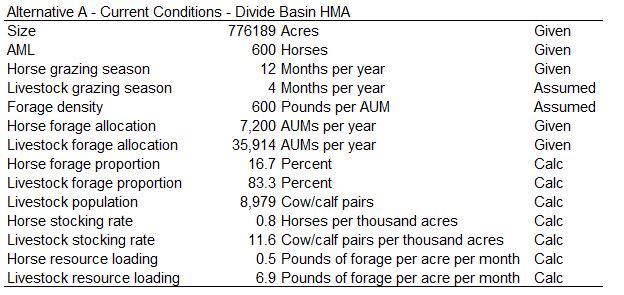The Tier 1 analysis in Appendix A of the draft EIS for the Rock Springs RMP amendment provides data for current conditions on the Divide Basin HMA.
Those numbers were copied into a spreadsheet to see how wild horses are managed relative to other mandated users of public lands.
The EIS did not provide allotment sizes, grazing seasons, and animal types within the HMA. The grazing season on some of the allotments is three months and on others it’s four to six months, according to Section 3.10 of the EIS, so an average grazing season of four months was assumed.

Management indicators for the other mandated users were computed on the basis of cow/calf pairs, whose resource requirements are equivalent to those of wild horses, allowing a side-by-side comparison.
The results are presented in the following charts.

The indicators show that the HMA has not been managed principally for wild horses, as required by paragraph 1332(c) of the statute.
The horses have a smaller footprint and environmental impact compared to livestock, but the RMP amendment will eliminate them under the preferred alternative.
“Hey WHW, what about CFR 4710.3-2? The government doesn’t have to manage HMAs principally for wild horses unless it chooses to do so.”
Good question.
Can a federal regulation trump a duly enacted statute? That would be a substantive comment on the EIS, although it might pertain more to the Adobe Town HMA, which will be downsized in the revised RMP but not wiped out.
RELATED: Adobe Town Horses Get Short End of Stick.

